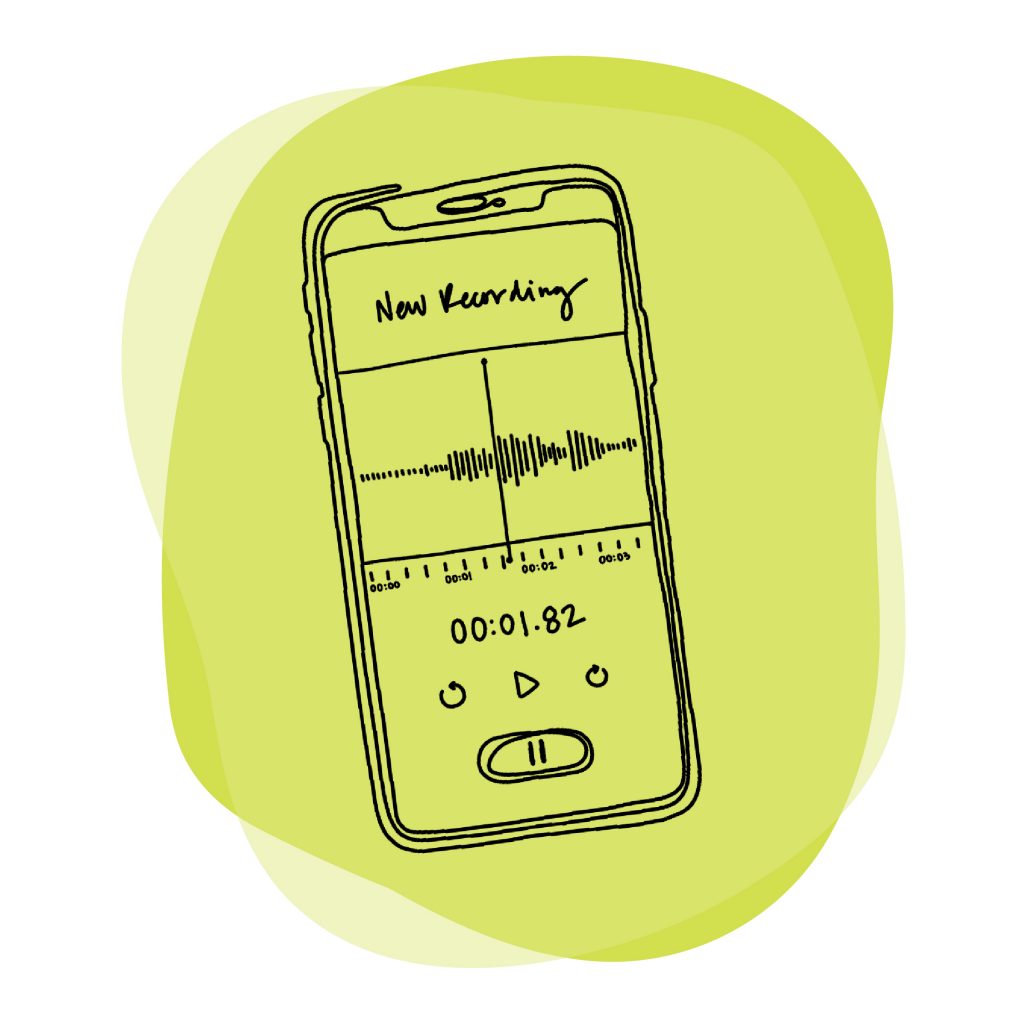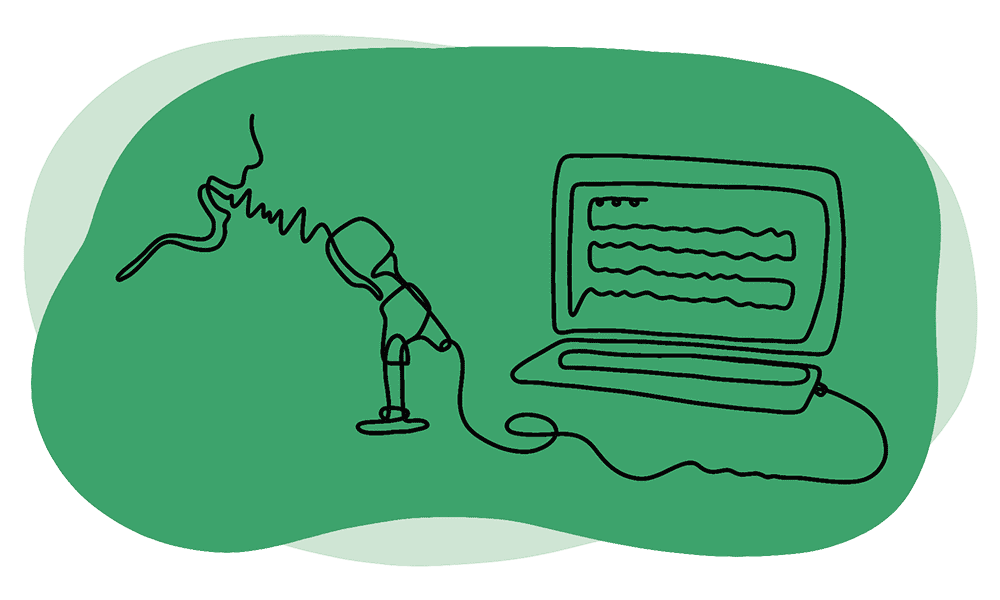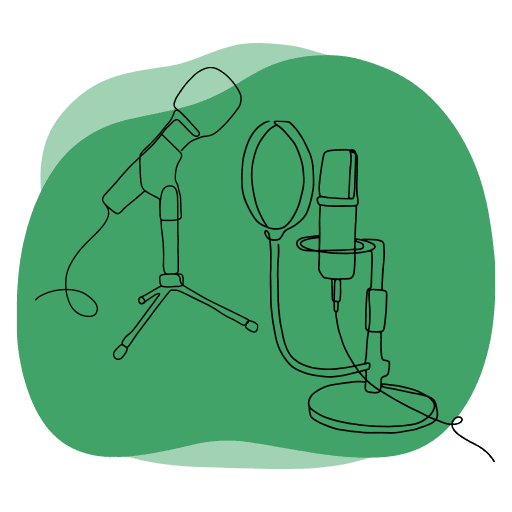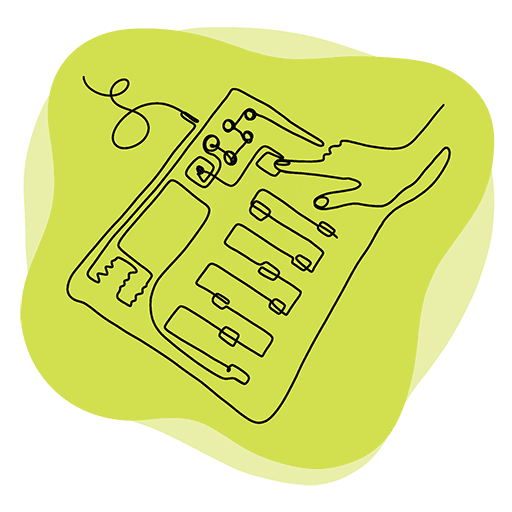Post updated on November 23, 2020
This is part of Libsyn’s blog series, “How To Start a Podcast —Step by Step for Every Kind of Podcast.” Check out the introduction to the series, including levels of podcasts, and the previous post about podcast studio setup.
Here we are! One of the favorite topics of all podcasters: podcast equipment and setup guide!!!
The basic equipment needed for recording and editing a podcast:
- Something to record with and into (hardware plus software)
- Microphone
- Headphones
- Digital Audio Workstation (DAW)
- Internet!
Level 1 Basic Podcast Recording Equipment
If you’re looking to start your Level 1 Podcast (here’s what we mean by Level 1) and want cheap and basic podcast equipment, look no further than the smartphone in your pocket.
Most of the latest smartphones have high-quality microphones built-in, including apps for audio recording.
On an Apple device, you can use the built-in Voice Memo app for basic recording.
On Android, download Auphonic Recorder from the app store — it’s free.
You could record your show and publish it using a smartphone only. Basic podcast recording apps allow you to do rudimentary editing, and most podcast hosting companies like Libsyn allow for publishing via mobile devices.

Another basic podcast recording setup is to use your computer’s built-in microphone, a built-in digital recording app (Garageband for Mac OS), or a free one like Audacity.
There are no laws in podcasting that require you to get more stuff.
If you are strapped for funds or are looking to start testing the waters with podcasting, start with what you have.
Learn to use your existing tools – your very basic podcast recording equipment like your smartphone.
Get familiar with the basics of how to record and edit a podcast. This is a great way to not only learn about starting a podcast but also find out what you might like to invest into leveling up your podcast production.
Refer back to blog post #3 in this series that is all about the podcast studio setup. You might be surprised by your recording’s quality if you consider your surroundings and do some test recording to ensure you get the optimal sound given your circumstances.
PODCASTING TIPS
• There is no one piece of equipment that will magically make your show sound amazing.
There is almost no correlation between the cost of podcast equipment and how professional you sound.
Here are three principles to learning how to make your podcast sound better:
1. Get to know your podcast recording and editing tools.
These podcast recording tools include editing software, computer settings/specs, microphones, digital recorders … essentially anything that you will be using to record, edit, and process.
Why?
It doesn’t matter how high end your microphone is if you don’t know how to use that specific microphone.
It doesn’t matter how amazing your digital recording software is if you don’t know how to use it to make your audio sound good – a lot of digital audio workstations have the same vocabulary but also have their own quirks.
You get to know your podcast recording tools by engaging with them and testing them out. This means you’ll need to invest time tinkering with the tools, research for videos and tutorials for general understanding, and solve problems that arise as your podcast, which leads to our second principle.
2. Be open to learning.
Once you start creating your episodes, you will find that there is a lot that you don’t know. You will also bump into issues that are unique to you, your life, and your podcast studio setup.
Be willing to do the research to find solutions, as well as to realize when others’ solutions don’t apply to you.
Sometimes the solution does not involve having to buy another thing. Sometimes it does, but not always. You’d be surprised how many times a small tweak in how you use a microphone, change a location, or modify a software setting can be everything that you need.
There is no better skill set than podcast troubleshooting.
Lastly:
3. Get the best quality raw audio.
Raw audio = the initial audio recorded before anything is done to it.
Your voice to the device that captures your voice to the recording.
If you have the highest quality recording initially, you will be able to offer the highest quality final product.
One of the most painful podcast mistakes that newish podcasters make is thinking that any recording issues can be fixed in post-production, with editing and repair.

Some problems cannot be solved in post-production, and you will need to choose between releasing the audio as is or starting again.
An important podcast troubleshooting tip: Before you record, you must test to make sure everything is optimized for recording so that you can get the best initial quality from that raw audio.
- Are all proper podcast microphones picked in the software?
- Are all cords and connectors properly inserted?
- Are all cords and connectors in good health? As in not broken or tweaked?
- Have you checked your levels so that they are somewhere between -6 and -12 db?
- Are you wearing headphones so that you can hear all the things?
The best way to avoid future editing issues is to monitor yourself in the process. 99.9% of the time what you hear in your ears is what’s going to go on the recording.
Avoid the pain of dealing with things in post by taking the time to address it up front.
Level 1 – Upgrading from the Essential Podcast Equipment
To level up recording on a smartphone, you can add an external microphone.
There are some that are built in specifically for smartphones, depending on what kind of phone you have. They can connect via Lighting port or headphone jack.
Here are 2 examples of external microphones that can be plugged in to the headphone jack (TRRS), or lightning port:
- smartLav+ http://www.rode.com/microphones/smartlav-plus
- Shure MV88 https://www.shure.com/en-US/products/microphones/mv88
Or you can easily use any USB microphone with your smartphone.
My favorite cheap but good podcast microphone is the Samson Q2U Recording and Podcasting Pack.
Do remember that when using a USB microphone with your smartphone, you need to get a dongle to connect with your device. It can be USB-C to USB, USB OTG cable or Lightning to USB, depending on what kind of phone or tablet you have.
You can use the Samson Q2U dynamic USB microphone to uplevel the quality of recording into your computer as well.
Regardless of how you choose to record you should always use headphones.
Always.
Yep, we just mentioned this podcasting recording tip in the prior section. We are mentioning it again. It’s that important.
You need to monitor not only the audio that you’re recording but also yourself.
AGAIN: What you hear in your ears you will hear in the recording, and you’re better off dealing with it in the moment rather than later on when you’re editing.

PODCASTING RECORDING TIPS
• If you hear lots of popping “p” or mouth noises coming from you, you can adjust appropriately. How do you do that? You test yourself speaking and adjusting the angle of how you speak into the microphone. You could solve the problem by shifting your mouth’s position when speaking “p’s” or “s’s” or any other vowel that gives you issues.
This also applies to adjusting your distance from the microphone, so that if you happen to have to take a big deep breath you don’t sound like Darth Vader.
• If you hear a lot of hissing, interference, or weird clicking sounds as you’re recording, you can take the time to make sure that all of your hardware and software is connected properly and that you’ve moved any other cellular devices away from your gear. This will help you make your podcast sound better.
• For headphones, basic earbuds work surprisingly well for podcast recording tools. You can level up by upgrading to higher-quality headphones when you’re ready. Most people prefer over-ear headphones while they monitor and edit, to better block external noises.
To edit the recording, you can do fundamental editing on your phone. Most of the free audio mobile editing software is very basic. If you want any kind of advanced features you will have to invest in more powerful apps. Some apps allow for in-app purchases that open up more advanced functionality
A great recording studio app for iOS is the Ferrite podcast app. One that folks love for Android is Voice Pro.
Or you can transfer the audio file to a computer and use Garageband (Mac – and you can use it with your iPhone or iPad) or Audacity (Mac or PC), both of which are also free and widely used.
PODCASTING TIP
YouTube is a wealth of information when it comes to figuring out how to use hardware or software. If you get stuck on anything, head over and search for the podcast recording device or the software. Your investment is your time and your brain.
Level 1 – Podcast Setup for Two (recording more than one person in the same place)
For the sake of podcast setup on budget, here is what you need to record more than one person in the same place:
- recording device
- software
- microphone
- headphones
- possibly an external microphone and microphone stand
You will either have to place whatever you’re recording into in between you and whoever you’re recording with, or invest in a USB microphone. You will have to either hold it and aim it at everyone’s mouth or set it on a microphone stand in the middle of the room.
You will then pray that the recording isn’t too horrible, and you will bust your bum to learn how to make magic with Audacity or Garageband as you edit and process your audio.
This is where the location of your professional podcast setup can really make or break your sound quality.
If you can find the optimal location for recording, and you all are committed to the best way to record a podcast (coming up in a later post), you will get a not-so-crappy recording. In fact, it might be surprisingly ok.
In this podcast recording set-up, you will learn by doing and failing. Every time you get a sub-par recording, you will make sure you don’t do it again.
When you do not have the funds to invest in podcast gear, you must invest in the practice of podcasting through time, education, and most importantly doing, failing fast and doing it again.
Level 2 – Podcast Equipment Setup
A good basic podcast equipment setup can be quite affordable while still being of professional quality. Recommended podcast equipment are:
- Either a Mac or PC computer (desktop or laptop is fine), or an external digital recorder such as any of the Zoom recorders (H1, H2N, H4, H6)
- Microphone: Samson Q2U or Shure SM58
- Foam mic cover (to reduce wind and breath noise)
- Podcast microphone stand or podcast boom arm (to keep your mic steady and near your mouth while you’re recording) — Which to choose depends on your set-up. If you’re going to be changing locations a lot, this adjustable desktop microphone stand style is excellent. If you’re going to be staying in a permanent location, this one is a great choice.
- Studio earbuds or headphones — Whatever you currently have would be a fine option, though some people prefer over-ear headphones for better isolation. If you want to invest in some we suggest the Audio-Technica ATH-M20x.

- Podcast editing software such as Audacity (Mac or PC) or Garageband (Mac) — If you’re looking for something more from a Digital Audio Workstation (DAW), as this type of software is called), consider learning to use Hindenburg, Reaper, or Adobe Audition. All of those DAWs are cross-platform and have an abundance of educational material and communities supporting them online.
- Cords — You will need to connect one thing to another. We advise you to make a basic investment in USB to mini USB and XLR cables, although some of those basic cables generally come with the initial purchase of the hardware.
- SD card — These come with the purchase of a digital recorder, but most of the time they have very little storage. You can never go wrong investing in a high quality SD card.
- MOBILE EDITING APP: This is of course only for those that want to do editing on a mobile device. We suggest Ferrite for iOS.
A SUGGESTED BASIC SOLO PODCAST EQUIPMENT SET-UP WITH DIGITAL RECORDER
- Zoom H4N digital recorder- around $219
- Samson Q2U microphone – around $59-$79 (this comes with a little tripod and windscreen) Or Shure SM58 $99
- 128 GB SD card – around $20
- Podcast Boom Arm – $99
- Foam ball or pop filter – range $10 – $30
- Audacity/Garageband – free
SOLO PODCAST EQUIPMENT SET-UP WITHOUT DIGITAL RECORDER
Using a computer you already own
- Samson Q2U microphone – around $59-$79
- Podcast Boom Arm – $99
- Foam ball or pop filter – range $10 – $30
- Audacity/Garageband
SOLO PODCAST EQUIPMENT SET-UP WITHOUT DIGITAL RECORDER
Using a smartphone you already own
- Samson Q2U microphone – around $59-$79
- Appropriate cables – anywhere from $5 – $19 depending on your device
- Appropriate USB adapter for iOS – around $19
- Audio editing software – Ferrite for iOS ($29.99) and Voice Pro for Android ($13)
What is suggested above is the basic podcast equipment you need to upgrade your audio and start investing in Level 2.
There are other tools that can prove to be insanely helpful in creating a fantastic sounding podcast that won’t totally break the bank, and can prepare you to scale your show. Below is what we suggest you start off with if it’s in your budget.
- Samson Q2U – around $59-$79 or Shure SM58 $99 (this is an XLR microphone only)
- Boom Arm – $99
- Foam ball or pop filter – range $10 – $30
- 256 MicroSDXC card $34.99
- Audio-Technica ATH-M20x Headphones – $49
- Podtrak P4 – $199
This podcast equipment’s total cost is around $500, give or take, depending on which podcast microphone you choose and whether you find different prices for the accessories.
Can you get a different microphone than the ones we suggest? (Or other podcast gear for that matter?)
Yup.
It is hard to go wrong with the tried and true podcast equipment mentioned here. They can work in most environments and take a bit of a beating, which is great if you have a buoyant family, happen to do a lot of traveling, or need to change where you record often.
So, what is the best microphone for podcasting?
- Buy a podcast microphone from a place that accepts returns easily.
- Buy your podcast microphone based on your lifestyle.
- Test, test, test in the circumstances and locations that you’ll be recording.
- If the mic doesn’t work or you don’t like it, exchange it for something else.
The internet is full of articles on the best podcasting microphones.
The internet is also full of very passionate podcasters that loooooove their gear and have very definitive opinions about what you should get (aka highly opinionated). Bottom line: The best podcasting microphone is the one that works for your lifestyle and your goal.

You can make a lower-end microphone sound like gold, and you can make a very high-end microphone sound like poop.
It’s not about the podcast microphone.
Level 2 – Podcasting gear to record more than one person in the same place
Podcast Setup for Two
To get the best possible recorded audio so that you can then edit and create magic with the end product, record on separate tracks with separate microphones.
Here are two types of podcast set-ups for two that will give most people the best results in real-life recording situations:
With these suggestions, you would need to multiply the podcast microphones and accessories based on up to 4 participants.
Mobile Podcast Recording Equipment Setup
For you
- Zoom H6 $329.99 or Podtrak P4 $199
- Samson Q2U – around $59-$79
- 5-Way Multi Headphone Audio Splitter Connector $9.49 (not needed if using Podtrak P4)
- Audio-Technica ATH-M20x Headphones – $49
- 128 GB SDXC card $28.99
For EACH of your guests
- Samson Q2U – around $59-$79
- Over the ear headphones – Suggested Tascam TH-02 Closed Back Studio Headphones – $16.63
Stationary Podcast Recording Equipment Setup
For you
- RODEcaster Pro – $599
- Samson Q2U microphone – around $59-$79 or Shure MV7 $249
- Podcast Boom Arm – $99
- Foam ball or pop filter – range $10 – $30
- Audio-Technica ATH-M20x Headphones – $49
- 256 MicroSDXC card $34.99
For EACH of your guests
- Samson Q2U microphone – around $59-$79 or Shure MV7 $249
- Podcast Boom Arm – $99
- Foam ball or pop filter – range $10 – $30
- Over the ear headphones with a ⅛ inch adapter (the RODEcaster Pro only takes ⅛ inputs) – Suggested Tascam TH-02 Closed Back Studio Headphones – $16.63

Podcast Equipment Level 3
Oh! High end podcasting!!!
As we mentioned in our last post, in many cities podcasting studios have been popping up. Wherever you are in the world, take a moment to do some research. A lot of them also offer post-production of your show. Co-working spaces have also seen the popularity of podcast production grow and have started to add recording studios to their co-working spaces.
Depending on what you need, you can either rent the space just for yourself, as you would your own office, or you can rent by the day or hour.
UPDATE! At the time of publishing this post, COVID-19 had not quite swept the world and impacted every single aspect of life.
Although there are still office spaces, recording spaces, co-working spaces and recording studios to record a high end podcast, you’d have to do the research and be mindful of protocols.
In addition to deciding on your recording space, you also need to seek out audio professionals to do the post-production for you.
There are many podcast production companies that offer concierge type services, ranging from the editing of your show to a full suite of services: audio production, publishing, transcription, and show notes!
A lot of podcast production companies have also adjusted to doing more virtually.
One last option is to research for local independent audio production pros. These individuals will develop just-for-you proposals and work hand in hand with you in developing your show.
Many have started to offer mobile services, where they will come to you with their gear, set-up the whole thing, record it for you, and do the post-production.
That’s a fantastic service if you ask me!!
But what about the gear???
If you will be using a podcast recording studio, here are some questions for you to ask, so that you are prepared, and can make the best choices for recording!
- How do you charge for your editing services? By the episode or hour?
- Can I bring my own headphones to the studio? (Especially for the germ conscious)
- What brand of mic do you use, and why?
- If we’re recording an interview, what special instructions or guidance do I need to know?
- Am I able to record a remote guest? What do I need for that? What instruction will the guest need?
- What can I bring to the recording? Water, snack, friends?

Now if you want to have your own gear, in your own home studio, my suggestions are for you hire a podcast audio consultant to walk you through the process.
A pro will be able to provide insight about what you need given your environment and your budget.
Audio pros are able to provide support virtually or even in real life (with pandemic protocols and everything!)
Next Up: Get Ready to Record Your First Podcast
In the next post in this series, we discuss writing your first podcast script, preparing your recording space, setting up intros and outros, and other nitty gritty details. Sign up to get an email when the next post is published.
Have feedback on our recommendations? Connect with us online — Facebook, Twitter, Instagram, LinkedIn — and use the hashtag #AskLibsyn so we can respond to you in a future post!
You can also email [email protected] with the subject line #AskLibsyn . While you’re at it, check out our free podcasting quick-start webinars, The Feed: The Official Libsyn Podcast, our award-nominated podcast about podcasting, and our amazing podcasting knowledge base designed specially for people like you.

